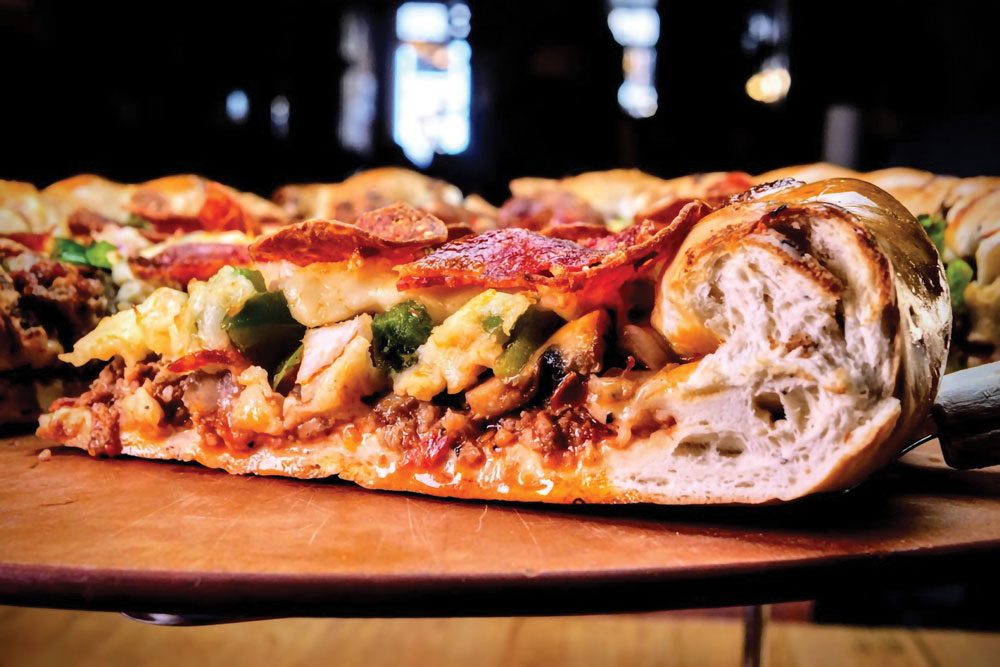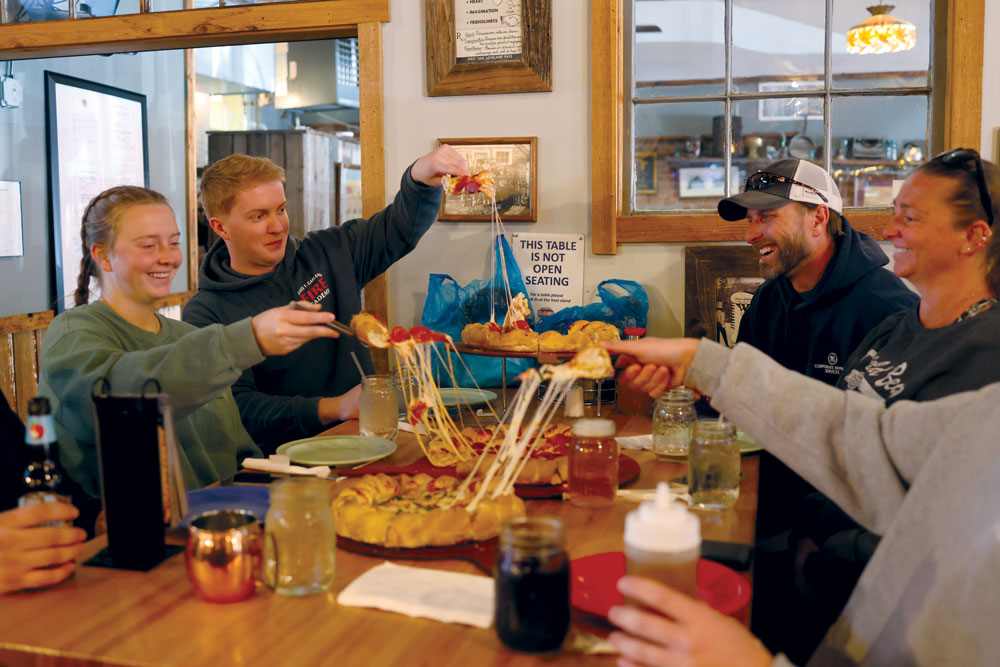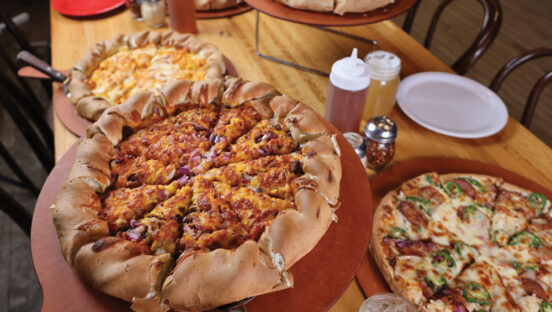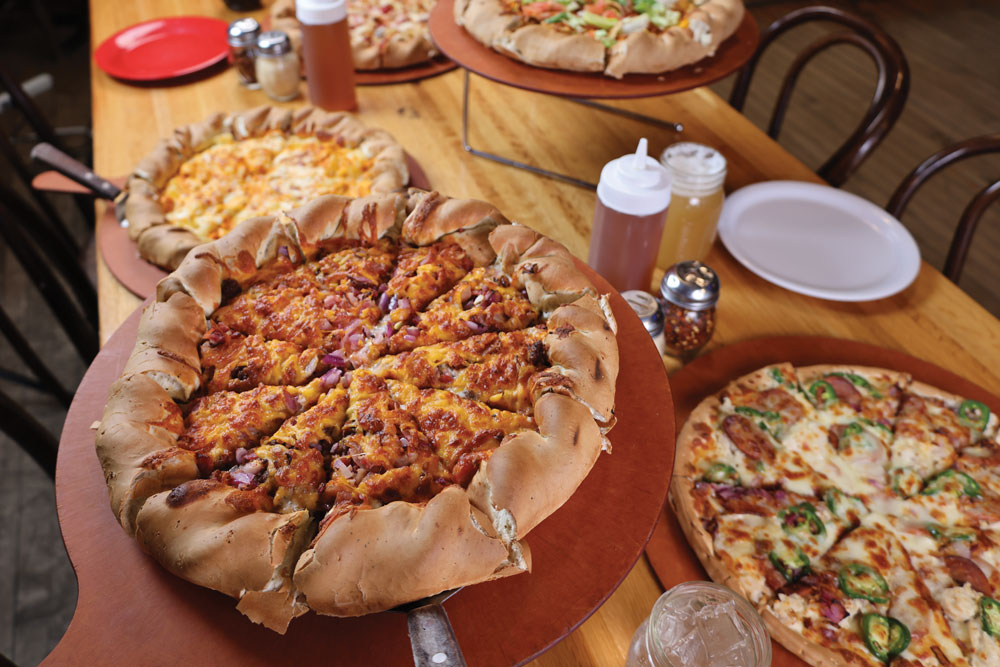By Tracy Morin | Photos by Beau Jo’s
Out West, everything looms large: mountainous landscapes, endless skies, bone-dry stretches of desert. Even the old-time frontier personalities seem larger than life, persisting today as icons who embody the rugged, can-do spirit of America. So it’s no surprise that Colorado-style pizza, also called the Colorado Mountain Pie, is every bit as hearty, and as full of pioneer ingenuity, as the Western backdrop where it was born.

Colorado Mountain Pie features a rolled crust and generous amounts of toppings.
Truth vs. Fiction
When it comes to pizza lore, some people want the truth, and some people want a good story. Luckily, this Western tale has a choose-your-own-adventure vibe—with Colorado-style pizza, you can have both. As legend has it, Beau Jo’s founder, Pete ZaPigh (pronounced “Za-Pie”), arrived out in Idaho Springs, Colorado, in the Gold Rush era. A French fur trapper by trade, he may have “appeared by spontaneous generation in Idaho Springs—either that or a cab from Trenton, New Jersey,” according to Beau Jo’s tongue-in-cheek history. He was in search of a woolly mammoth out West, but when years of searching proved fruitless, he entered an abandoned mine shaft and holed up for two years, until he emerged with a recipe that infused a classic with a Colorado twist. Thus, the Colorado Mountain Pie was born.
ZaPigh met his tragic end six months later, when he was trampled, ironically, by a woolly mammoth. But not before he’d managed to carve his recipe onto the shell of a local box turtle named Beau Jo. Only 75 years later did a man named Chip Bair literally stumble upon the recipe when he tripped over the turtle while out walking. “It was a difficult first few years for the company and its innovative pizza,” the lore reads. “The owner often carried a sleeping bag to his pizzeria to sleep on the floor. He ate pizza for virtually every meal to save money. When surrounding skiers found his new Rocky Mountain location, the Colorado-style pizza became a word-of-mouth sensation.”
“Food prices were increasing, and [owner Chip Bair] had to up his costs, so he started upping the amount of toppings, too. A waitress named Patsy May started rolling the edges of the pizza to contain all of the toppings.”
—Codi Bair, BeauJo’s

Crowds lined up down the street for Beau Jo’s 50th anniversary celebration.
Some of that may hold truth, but there’s also an origin story that actually happened—a tale that Beau Jo’s lays claim to as much as its fictional recounts of shadowy past-era pizza pioneers. In this version, owner Chip Bair bought Beau Jo’s (now with six locations and headquartered in Arvada, Colorado), from its previous owners in 1973. “It was a small pizza place in Idaho Springs,” notes Codi Bair, Chip’s daughter and current vice president of marketing. “Food prices were increasing, and he had to up his costs, so he started upping the amount of toppings, too. A waitress named Patsy May started rolling the edges of the pizza to contain all of the toppings.”
Meanwhile, another employee contributed to the style by making what was perceived as a healthier switch in the incumbent pizza dough of the time. Instead of the sugar that was usually added to the dough, he started adding honey. Then an employee decided to put the honey on top of the crust, too. Honey is now served at the table so that customers can dip their crusts in it—perfect for a built-in dessert. The honey is also sourced from the Rocky Mountains, helping to support nearby businesses and fostering the local-ingredient focus that became a hallmark of that other well-known Western style, created in California. (Today, the Beau Jo’s wheat crust is made with agave so that vegans have an option, too.)
While the rolled edge is one crust trademark, another is its crispy texture. But it’s made with a baking process that also maintains a soft, chewy interior. In addition, pizza at Beau Jo’s is sold by the pound: A small pizza is one pound, with diameters and weight going all the way up to extra-large, so it’s not a pie for the faint of heart (or weak of appetite).

With a “bigger is better” mentality, Colorado-style pies can easily feed the whole family.
A Humble Pie
Though the Beau Jo’s iconic style celebrated 50 years in 2023, it still feels like a niche obsession, a lesser-known pizza than, say, the California or Chicago styles that geographically bookend Colorado. However, the tradition of serving pizza with honey as a dipping sauce has certainly spread across Colorado, and today the honey-and-pizza trend has swept the nation. From Mike’s Hot Honey being born in Paulie Gee’s pizzeria in Brooklyn, New York, to Pizza Hut rolling out its own honey-topped pie in 2023, the marriage is officially solidified. But Beau Jo’s has made this so-called trend a way of life.
“I don’t think [Chip] knew how [Colorado-style pizza] spread so much until recently, when he was interviewed for a podcast. Serving pizza with honey has spread everywhere.”
—Codi Bair, BeauJo’s
Still, an underdog story fits owner Chip Bair’s own trajectory, whose beginnings and evolution are similarly humble. He completed the purchase of Beau Jo’s at only 25 years old, taking over from the previous owners, Beau and Jo Ann, after dropping out of college. Chip forked over $8,500 for the location. In 2023, as Chip sailed into the semi-retirement sunset with six locations (and now living part-time in Hawaii), he decided to continue the pizzeria’s legacy by giving back to the people who helped create his legendary pizza style in the first place: Beau Jo’s employees.
Chip made the announcement last April, informing everyone at a 50th anniversary party that he would be selling the company to workers through an employee stock option plan. “It’s the employees who made us, and they’re the ones who are going to continue to make us,” he told the crowd, the Colorado Sun reported. “I think we’ve done pretty good. And the employees really should get credit for that.”
In fact, even with five decades of history in the books, it’s only recently that Chip may be wrapping his head around just how much impact the Beau Jo’s Colorado Mountain Pie style has had, reverberating through the pizza world until the modern day. “He’s been running with the story for quite some time, that we created the Colorado-style pizza,” Cody says. “But I don’t think he knew how it spread so much until recently, when he was interviewed for a podcast. Serving pizza with honey has spread everywhere.”














